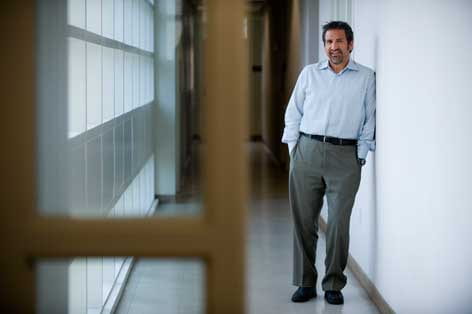Former 'street kid' now studies them
Professor who grew up in rough LA area credits family and social programs for his success in academia.

Though James Diego Vigil played the role of a tough guy while growing up near downtown Los Angeles, he never became fully immersed in street life. He wanted to be an athlete but eventually switched from boxing to books, earning a doctorate in anthropology at UCLA. Now a UC Irvine professor of criminology, law & society, Vigil has written several books on urban minority youths and Southern California gangs – subjects he knows firsthand.
“Poverty is at the root of the most serious gangs in Southern California and the nation,” he says. “What I focus on is the breakdown of social control in these neighborhoods. When things fall apart, kids are floating free and more apt to join gangs and become what I call ‘street-socialized.’”
Vigil credits a supportive family and social programs with keeping him out of trouble but notes that gang membership among poor, urban youths is overblown. “Only 10 to 15 percent of kids in gang areas join a gang,” he says, “and of those that do join, about 70 percent mature out within a year or after a stint in prison or a detention facility.”
The author of Gang Redux: A Balanced Anti-Gang Strategy, Vigil recently consulted for the American Civil Liberties Union on a case relating to gang injunctions in Orange and has collaborated on gang intervention programs with Homeboy Industries and the Housing Authority of the City of Los Angeles.
Here, he discusses his life, research and path from the streets of L.A. to the halls of academia.
Q. What are your thoughts on gang injunctions? Do they make our communities safer?
A. The record on gang injunctions is mixed. Research shows that they’re most often used in areas that are being gentrified or redeveloped – where you’re not really going after the bad guys, just getting rid of anything that smacks of negativity. Cities don’t want gangs or graffiti to ruin development plans. But I always tell police: You can’t solve a problem you didn’t start. There are social and economic roots to this issue. Address these roots and you’ll solve the problem.
Q. What types of intervention programs work?
A. I’ll give you an example: the Summer Night Lights program in L.A. For the last few summers, the city has given money to public parks to host a whole array of educational and recreational activities in the evening. It’s a way to change the culture of the neighborhood – occupy everyone’s time doing something constructive. It creates a healthy environment, instead of one where the parks are dark and full of gang members at night. We’re always telling kids to say no to drugs, no to drinking. What are we going to tell them to say yes to? Kids should be exposed to sports, learning and field trips – things that stimulate and engage them.
Q. You grew up in a rough part of L.A. How did you get from there to academia?
A. I grew up just south of downtown L.A. and was affiliated with two gangs – for a diplomatic character like me, it was possible! I was a street-socialized kid and had brushes with the law. But I was able to escape because there were programs that caught my attention and engaged me more than the gangs. One was the Catholic Youth Organization, where I learned how to box. Another was the Los Angeles Police Department’s Deputy Auxiliary Police program. In those days, city leaders stepped in to do something, and I benefited from so many of their social programs. I also give credit to my older sisters; they cultivated me to believe in myself. I dedicated my first book to them.
Q. You teach a course on film depictions of crime. Why is this important for criminology students?
A. The purpose of the course is to teach criminology, law & society majors that pop culture shapes people’s attitudes toward crime and how individuals should be punished or rewarded. We have to look at film not just as entertainment, but also as an art that influences how the public views the criminal justice system. You can watch a film like “Trading Places” and see how it deals with topics such as white-collar crime, insider trading, and nature versus nurture. And you’ve got to show Hitchcock and John Ford.
Q. You joined the faculty here in 2001. Why UCI?
A. I’m going to be very honest: I’m a beach guy. I fell in love with Corona del Mar. Last summer, I think I went there 15 times! I take a plastic cooler in which I camouflage a bottle of chardonnay and sit down to read my New York Review of Books. I can’t write at the beach, but it’s a great place to read and think. I dip my toes into the water if it’s warm enough and then head over to Bandera for dinner. I live a good life.


